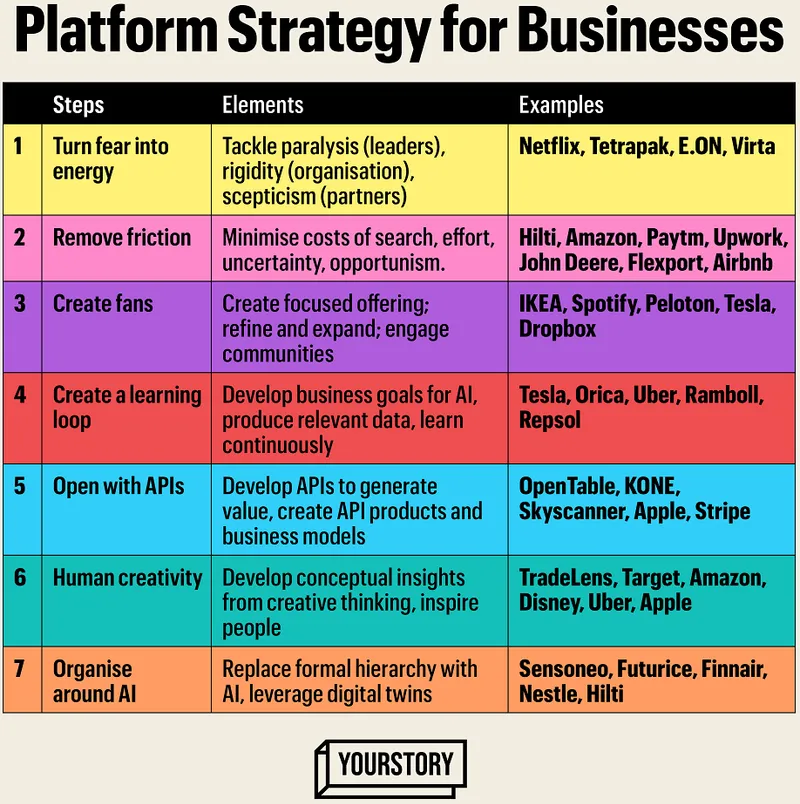Business transformation through platform strategy: sevens steps for ecosystem design and scale
This compelling book describes systematic approaches for launching and harnessing digital platforms. Packed with stories and business tips, here are some key takeaways.
Launched in 2012, YourStory's Book Review section features over 345 titles on creativity, innovation, entrepreneurship, and digital transformation. See also our related columns The Turning Point, Techie Tuesdays, and Storybites.
An insightful overview of the rise of digital platforms and business strategy is provided in the book Platform Strategy: Transform Your Business with AI, Platforms and Human Intelligence by Tero Ojanperä and Timo O Vuori.
Here are my key takeaways from the 200-page guidebook, summarised as well in the table below. See also my reviews of the related books Platform Scale, Winning in the Digital Age, Future Tech, Innovation Ultimatum, Seeing Digital, From Incremental to Exponential, and Machine, Platform, Crowd.
Dr Tero Ojanperä is the co-founder of AI lab Silo AI, and a venture capitalist. Professor Timo O Vuori is a strategy consultant and professor at Aalto University. Both authors are based in Helsinki, Finland.

Foundations
The growth of intelligent platforms is a recent event–even Steve Jobs was initially reluctant to open up the App Store at launch in 2008 to third-party developers for fear of loss of quality control, Nobel laureate Bengt Holmstrom explains in the book’s foreword.
As compared to physical marketplaces, digital platforms bring in advantages of speed, scale, smartness, personalisation, convenience, and risk management. APIs (‘algorithmic handshakes’) open up new channels for inter-organisational collaboration.
“It takes courage and skill to run open platforms,” Bengt cautions, citing the complexity and risks of ecosystem orchestration. Pioneering companies here include Amazon (API mandate in 2002) and Haier (outsiders can also lead employee teams for designing new products).
“You make a platform by having focus. Do one thing exceptionally well and then expand,” the authors begin, citing Apple and Tesla as examples.
Incumbent large firms have also launched platforms, such as elevator company KONE (platform for smart buildings), chemical company Lanxess (chemicals marketplace Chemedis), and agricultural manufacturer John Deere (open platform for partners).
In addition to platform-driven network effects and AI-enabled learning loops, companies need creative insights. “Intelligent platforms leverage human intelligence, creativity, and courage to make unexpected leaps expanding their offering scope,” the authors affirm.
“Fundamentally, category-breaking strategic moves require human creativity,” they add. Leaders must stimulate employee creativity. These tips and examples are well-captured in seven chapters in the book.

1. Turn fear into energy
Switching corporate strategy to launch the new platform game is not easy, and can lead to leadership paralysis, fear, panic, and denial.
Examples include Nokia’s lateness to enter the platform game and avoidance of Google’s Android, Microsoft’s acquisition of Nokia’s device business by Steve Ballmer (later written off by Satya Nadella), US newspapers’ early websites which were simply replications of the print edition, and NASA engineers’ early discomfort with open innovation.
Causes of such fear include loss of control, business model change, and reduced room for personal judgment. As corrective measures, the authors advise collective mindfulness, psychological safety, small early wins, and early partnership outreach.
At the organisational level, continuous participatory communication and capacity-building initiatives help employees see the big picture and respond accordingly. With partners, early communication, clear articulation of vision, and a sense of momentum are advised.
Successful exemplars include Netflix (from DVD to streaming), Tetrapak (spare parts marketplace), energy company E.ON (AI literacy initiatives), and e-vehicle charging firm Virta (more visibility for partner brands).

2. Remove friction
Causes of friction include high effort, time and money involved for activities like search, which lead to anxiety and uncertainty. “Successful platforms started from identifying industries and processes that had high friction,” the authors observe.
Use of technology, intelligent matchmaking, fewer decisions, leveraging unused assets, and building powerful brands can help in this regard. Undesirable behaviours can be flagged off by transparency, feedback, and governance rules.
Examples include power tool giant Hilti (tool delivery and servicing via fleet management), Amazon Prime (faster delivery), Paytm (QR codes for payment), Upwork (rating systems for freelancers), and Gubbe (connecting youth to elders for companionship).
Other cited practices are by John Deere (predictive maintenance), Uber (tracking car location), Flexport (supply chain digitisation for visibility), Maersk-IBM’s Tradelens (blockchain for trade visibility), and Airbnb (guarantees against home damage).

3. Create fans
The authors recommend a focused launch for a platform, followed by experiential engagement and expansion. Experimentation, exploration, and emotional nudges help here.
Examples including Amazon (starting with books; recommendation engines), IKEA (acquisition of Task Rabbit), Spotify (focusing on streaming instead of downloads), and Facebook (starting in campuses).
Other cited examples are Peloton (beginning with bikes and cycling classes, then treadmills and yoga with multilingual instructions), Tesla (continuous improvement via software updates; problem solving by users on its Facebook community page), and Dropbox (growth via referrals).
“Let the community do the talking for you,” the authors advise. Community managers can help here, via online and offline interactions.

[Year in Review] Meet these Indian women who used social media to drive change and social impact
4. Create a learning loop
AI-powered learning loops are key to creating a virtuous cycle of insights and predictions. Data preparation here involves handling incomplete, erroneous or corrupted data.
Examples include Tesla (car data collection and updates over the air), Australian explosives company Orica (improve blasting outcomes), Uber (surge pricing), Danish engineering company Ramboll (predicting water quality), and Spanish energy company Repsol (efficient drilling).
“Rules on how to share data and the rights of each partner are very critical,” the authors advise. Explainable AI is another emerging concern in this field.

5. APIs
“It is not enough to innovate internally. You need external partners to create compelling services for your customers,” the authors urge.
APIs help create such an ecosystem of partners virtually and automatically, as seen by Google (Google Maps), OpenTable (Uber booking), and John Deere (data transfer from farmers’ equipment).
KONE has leveraged its APIs for service robots in hotels and elevator calls to enable partnerships with Robotise (delivery robots) and Blindsquare (navigation app for the blind).
“Develop APIs as products and define a business model,” the authors advise. This involves product owners, roadmaps, communication plans, and lifecycles for internal and external APIs.
Companies need to figure out what to charge, when, and how much for API usage. Goals, metrics, and governance models are key here to develop future-proof platforms. “Security, privacy and quality audits are part of the process,” the authors add.
Other examples are Finland’s OP Financial Group (internal APIs), Skyscanner (revenue share with apps and websites), and Apple (developers’ conferences). Leaf and Stripe have API-first models.

Opening markets and mindsets: What to expect from India’s femtech sector in 2022 and beyond
6. Human creativity
An outstanding chapter shows how creating the unexpected and making disruptive leaps call for conceptual insights from creativity and out-of-the-box thinking.
The authors advise steps like trend tracking, analogies from other industries, what-if thinking, team diversity, creative spaces and activities, external partnerships, and acquisitions.
Examples include Uber (moving from limos to regular cars, UberRush, UberEats), Amazon (launch of Kindle, Alexa, AWS; acquisition of Whole Foods), Disney (launch of its own streaming service), TradeLens (by Maersk and IBM), and Apple (from iPhone to smartwatch).
A useful framework to assess a company’s strength is Jay Barney’s VRIN (valuable, rare, inimitable, non-substitutable). Alternative uses of strengths should also be considered, eg. Tesla (from car batteries to home and solar energy).
Such strategies involve a combination of inside-out and outside-in thinking, and even acquisition of companies with platform capabilities. Examples of such acquisitions include Visa (Plaid), Target (Shipt), and Facebook (Instagram, Chainspace).

7. Organise around AI
This provocative chapter suggests that AI be used not just for processes and data, but also for reworking organisational structure.
This includes task allocation, formation of teams, and change communication. Examples include Sensoneo (design of garbage collection routes), and Futurice (matching patients with doctors and even furniture companies).
“An AI can see everything at once, all the time,” the authors observe. This capability can help better coordinate core processes. Other uses could be to tailor messages based on employee communication style.
AI can be efficient and free of bias, to some extent. Despite AI’s autonomous capabilities, there should be a role for humans to make the final decision. Having an explanation interface, or building human trust in AI, can help here.
Other scenarios involve digital twins of factories and even humans, eg. Finnair (for handling flight congestion), Nestle (factory in Juuka), Hilti (building information modeling).
The book ends by showing how though Nokia’s phone business did not survive the platform era, the company has transformed itself for the world of 5G networks. Many of its employees moved on to work for platform strategies at other companies like Goldman Sachs, Thomson Reuters, KONE, Google, and Hilti.
In sum, the book provides compelling case studies and frameworks for organisational business transformation using platform strategies (see more resources in the online companion). The stories and references will be useful for aspiring platform-first startups as well as incumbents diversifying into platform space.
YourStory has also published the pocketbook ‘Proverbs and Quotes for Entrepreneurs: A World of Inspiration for Startups’ as a creative and motivational guide for innovators (downloadable as apps here: Apple, Android).
Edited by Megha Reddy







